We chose to stay a month in Brasov , and it is an excellent base for exploring Transylvania. Most (all if you have a car) of these day trips can be done on your own or with a tour. Different companies offer a large variety of both private and group tours. We discuss a handful of these day trips from Brasov here.
Poiana Brasov Ski Resort
Poiana Brasov is a scenic mountain resort in the Postavarul Mountains 20 minutes by bus from Brasov on bus 20 from Livada Postei. The bus runs every hour or half hour depending on the time of day and day of the week. Check the easy-to-navigate website for information. It works best if you open the site in Romanian and then click to translate. Buy two tickets per person at the kiosk before leaving Brasov. Then you will have a ticket for the return trip.
Be sure to stamp tickets when getting on the bus. On our two times up there, there were inspectors on the bus one time. Note that there are two different kinds of ticket stamping machines. One has a British and Romanian flag on it and gives a little stamp on end of the ticket. For this one, insert the ticket into machine with the printing face up. The other older (we think) machine puts a whole date stamp on the ticket, so insert upside down. The bus inspector appeared none too happy with us when we did this wrong.
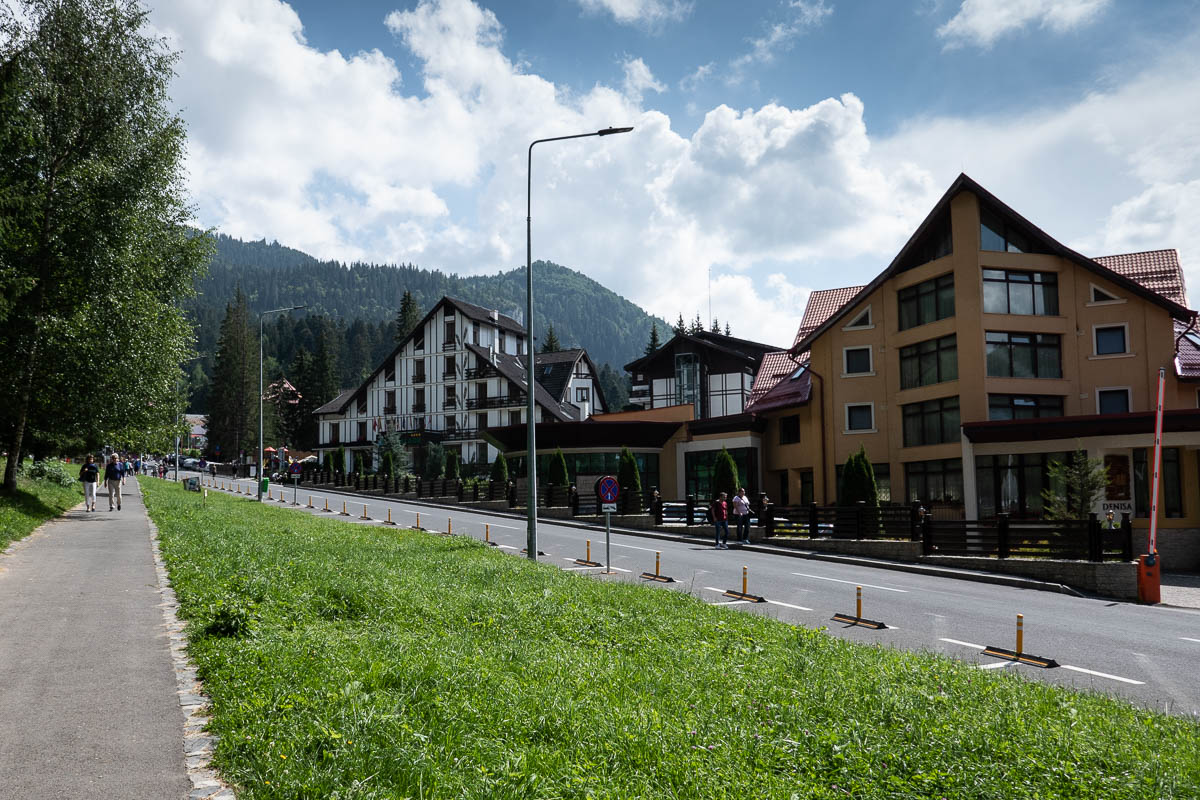
Hiking at Poiana Brasov
The one lift open during summer is a cable car to the top. It is about a 15-minute walk from the bus stop along the main street lined with hotels, restaurants and bars. Plus, a small amusement park for kids. During summer, the cable car costs 25 lei* one way or 35 lei* round trip. We rode the car up and walked down mainly along the service road.
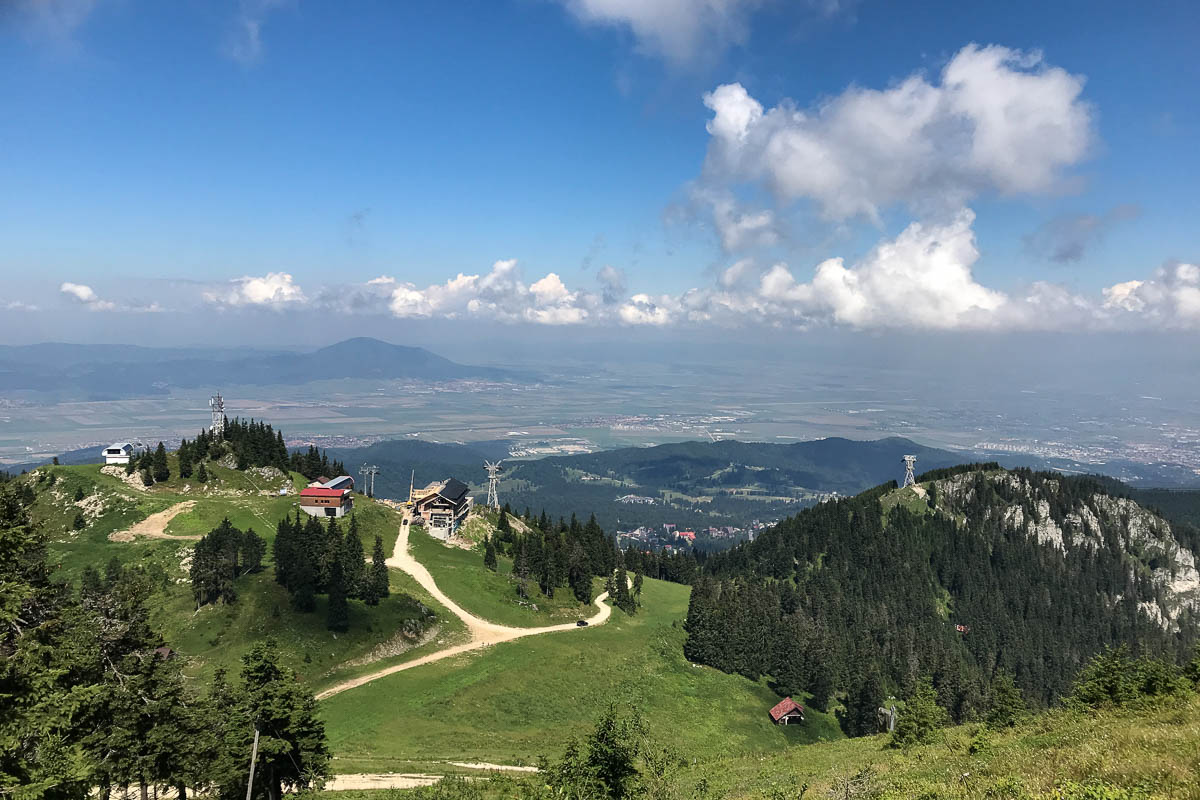
The service road, steep at times, is made of loose rocks and hard pack. It is exposed to the sun most of the way. Another trail, marked with a red cross, crisscrosses the service road, sometimes following the road, sometimes cutting through the forest. We did part of the way on the red cross trail, which is one of several hiking trails on the mountain. What we were told would take an hour and a half going down took us 2 ½ hours. We were going slowly at certain times to avoid falling, which Ian did one time anyway, fortunately without injury.
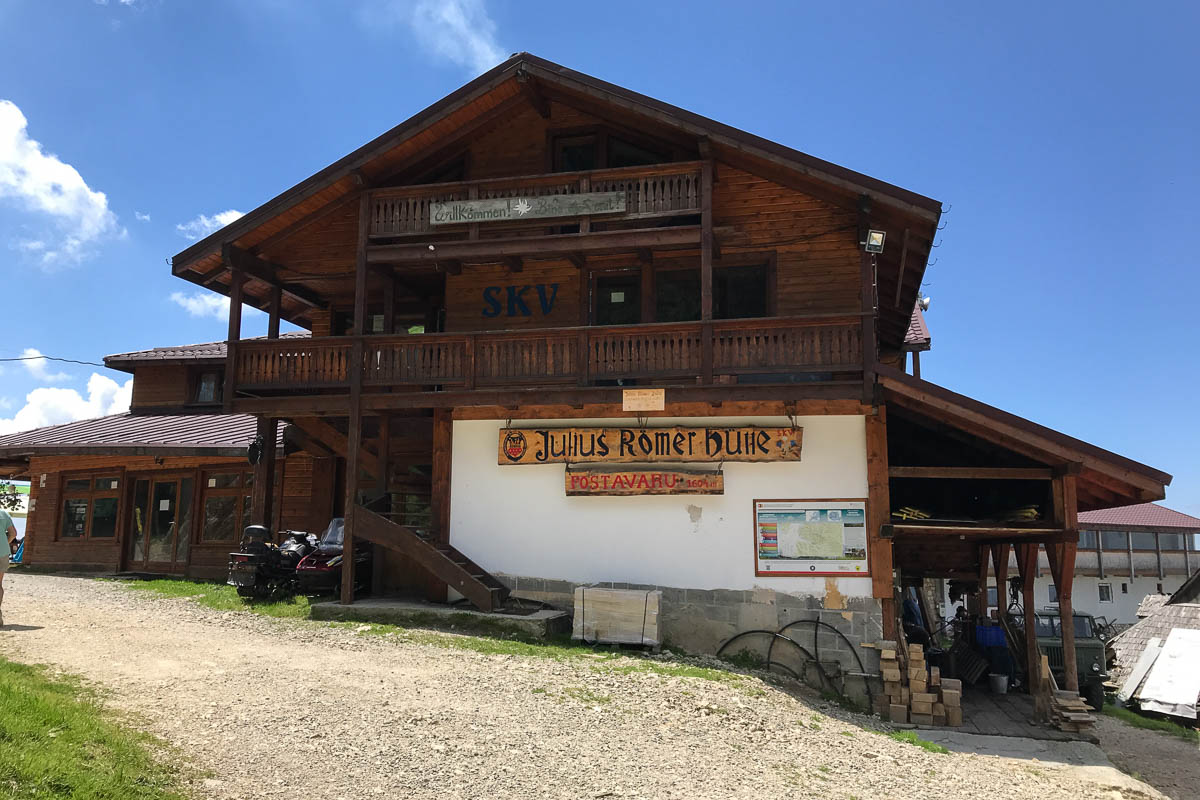
The day we went, we shared the mountain with a large group of kids (requiring several trips in the lift) from a summer camp. So, we ended up waiting almost an hour. We hadn’t planned very well and didn’t have any food with us. Imagine our pleasant surprise when about one-third of the way down, we ran into a chalet guest house and restaurant. For lunch, we enjoyed a bowl of soup (soup is big in Romania), bread, and complementary melon and schnapps.

We spent several hours on the mountain in Poiana Brasov with spectacular scenery and tranquility (when we weren’t around the group of kids). We strongly recommend this experience.
Bran Castle
Bran Castle, aka “Dracula’s Castle”, is perhaps the most touristy attraction in Romania. It’s accessible as a day trip from Brasov by a 45-minute bus ride from Autogara 2 bus station every half hour during most of the day. To reach Autogara 2, take local bus 41 from Livida Postei. Bus 28 also gets pretty close, bus 16 does not, but Google Maps thinks it does. (Guess who learned this the hard way?) From Autogara 2, take the bus marked for Bran and Moieciu (one stop past Bran). It costs 8 lei* each way and takes about 45 minutes. Except when the road is being repaired, which we were told has been going on for a while. At times, it was a one-lane road, but we saw no workers. With no air conditioning (we saw vents), windows that don’t open, and passengers having to stand, the ride was quite uncomfortable on the day we went in July.

Arriving in Bran, you can see the castle from the bus stop. Go left; it’s a 10-minute walk. You will know you’ve reached the entrance when you see a street lined with a gauntlet of vendors, stands, all selling the usual paraphernalia. By far the biggest tourist trap town we’ve seen in Romania. We waited in line to buy tickets about 45 minutes. Entrance was 40 lei* for adults, 30 lei* with senior discount. Once through the ticket office, it’s a 10-minute walk up the hill through the gardens which are amazingly tranquil. As you walk up the hill, the castle strikingly appears to be growing out of the rock face.
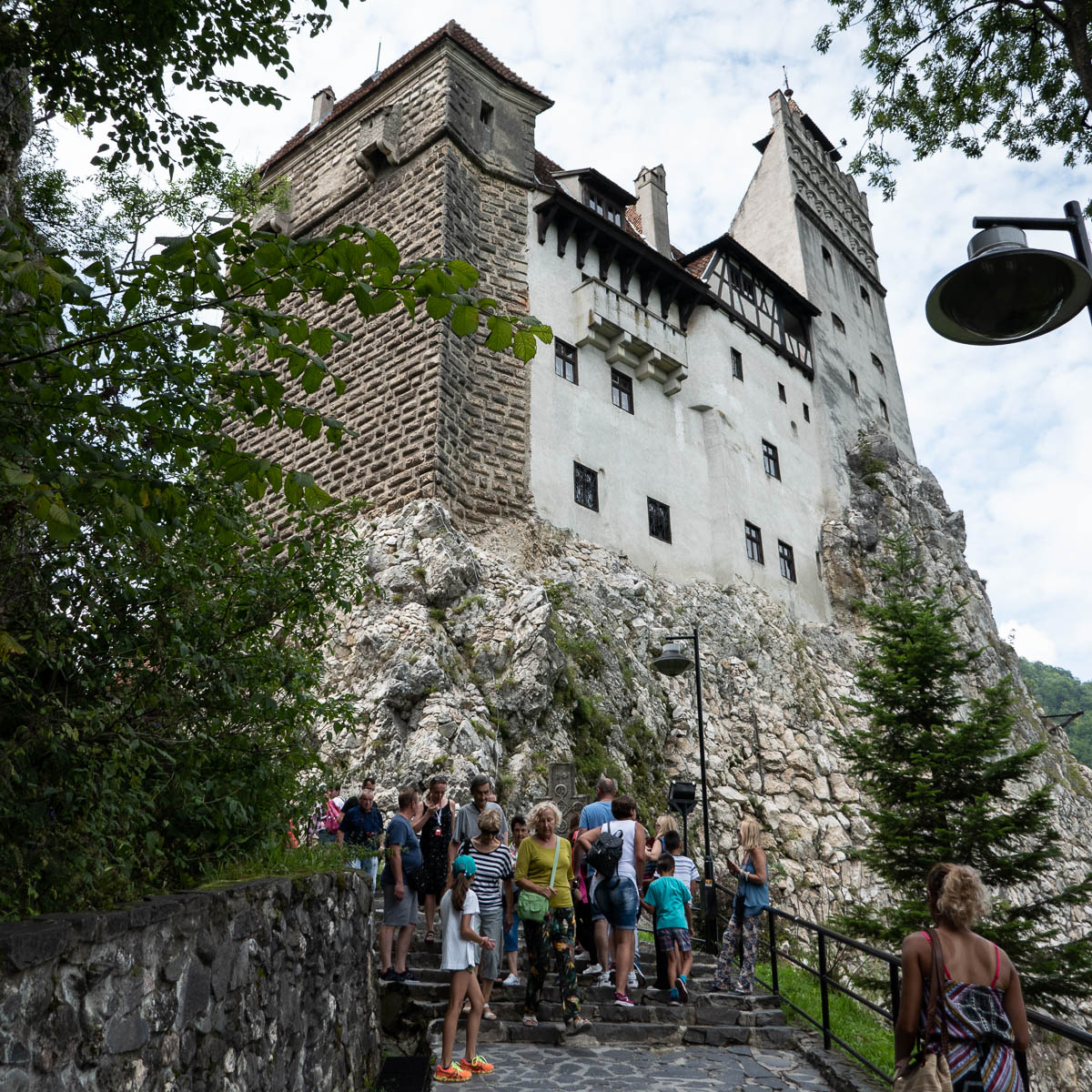
Inside Bran Castle

The castle really plays up it’s almost non-existent ties to the Dracula legend, loosely based on Vlad the Impaler (who never actually lived in the castle). The castle has a long history, beginning with the Teutonic Knights in the late twelfth century and ending with royalty.
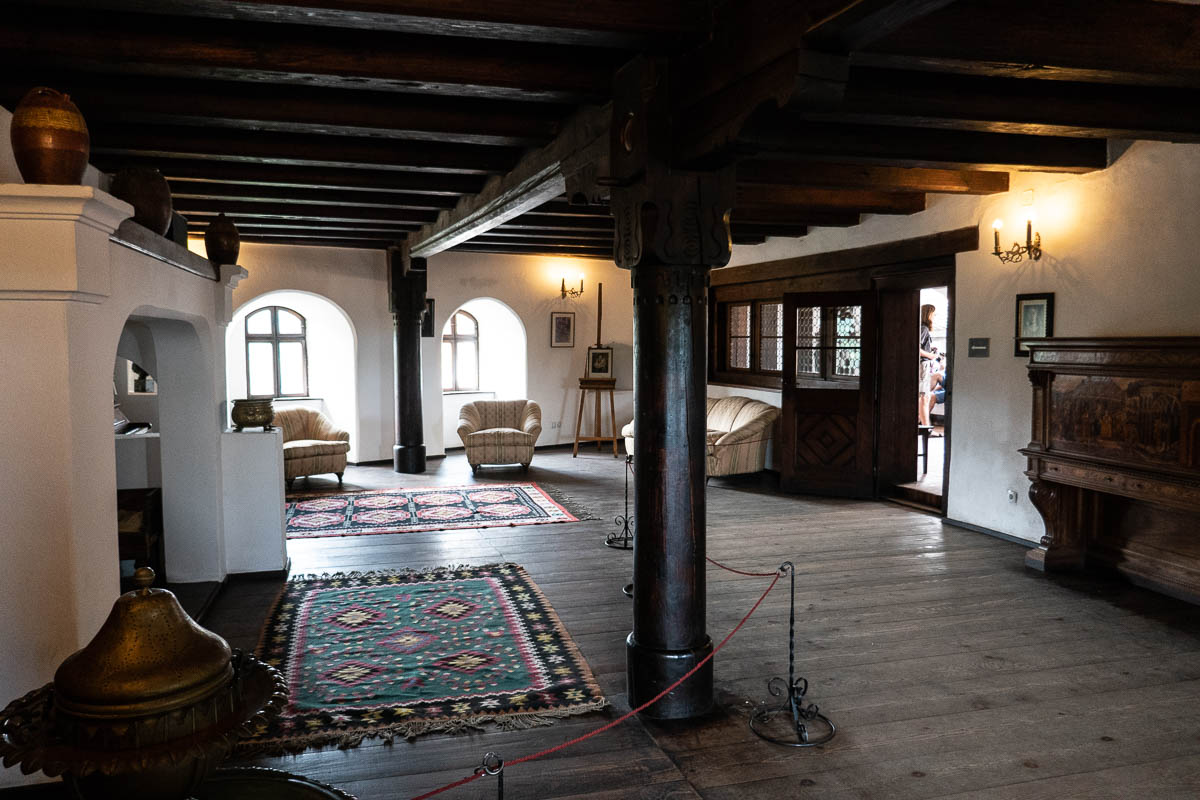
Once inside, you follow a one-way path around the castle, which is nicely furnished (unlike some in Western Europe which are empty). Even with the hassle of getting there and the crowds, we think the castle was worth visiting.
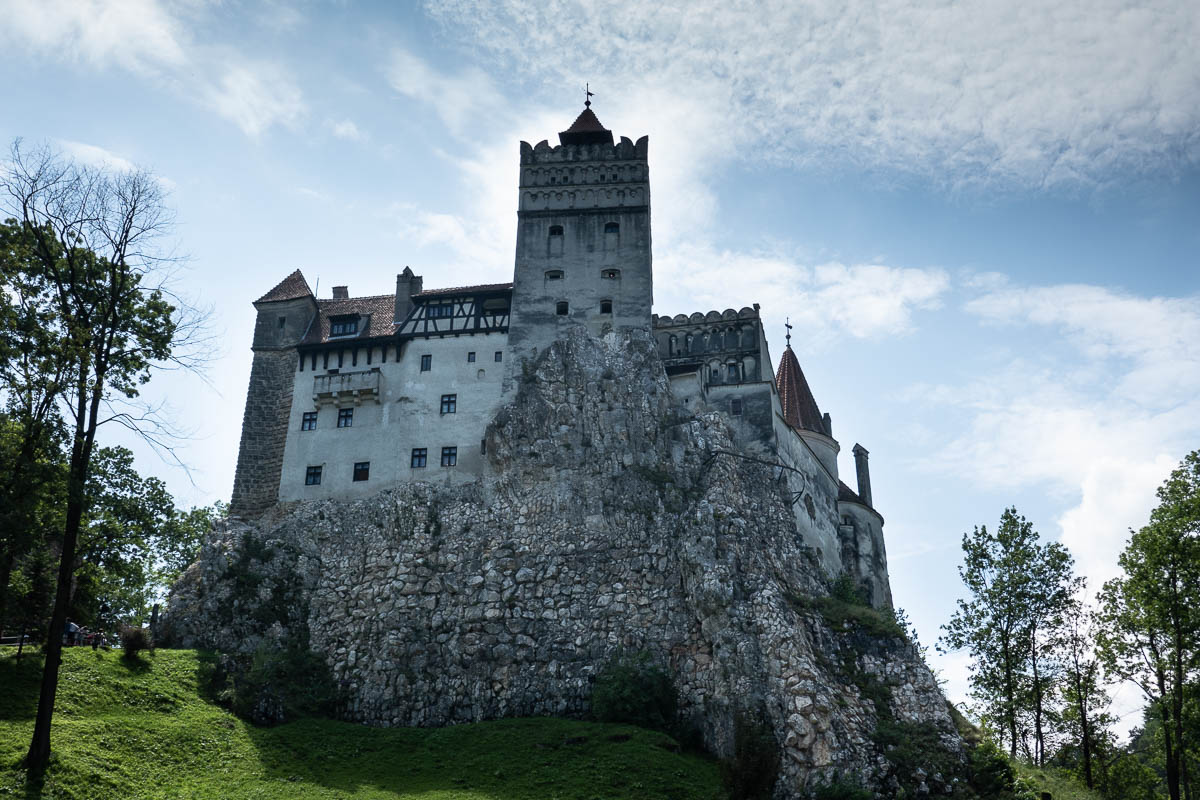
We got out of Bran, the town, as quickly as possible and took the bus heading back to Brasov, stopping off in Rasnov.
Rasnov Citadel
Coming from Bran, we got off the bus on the main road at the stop just after the signs for Rasnov Citadel.
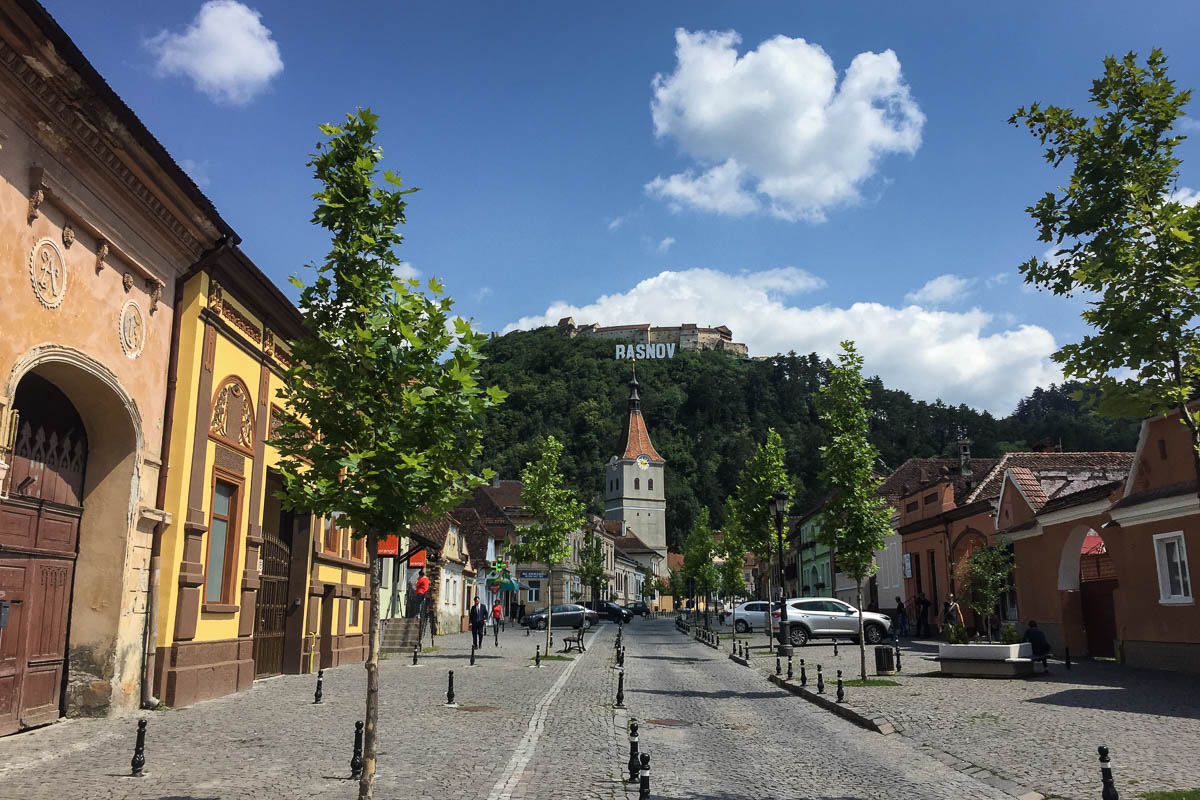
You can see the citadel perched on top of the hill. In contrast to Bran, the center of Rasnov was a delight: quiet, with very few tourists.
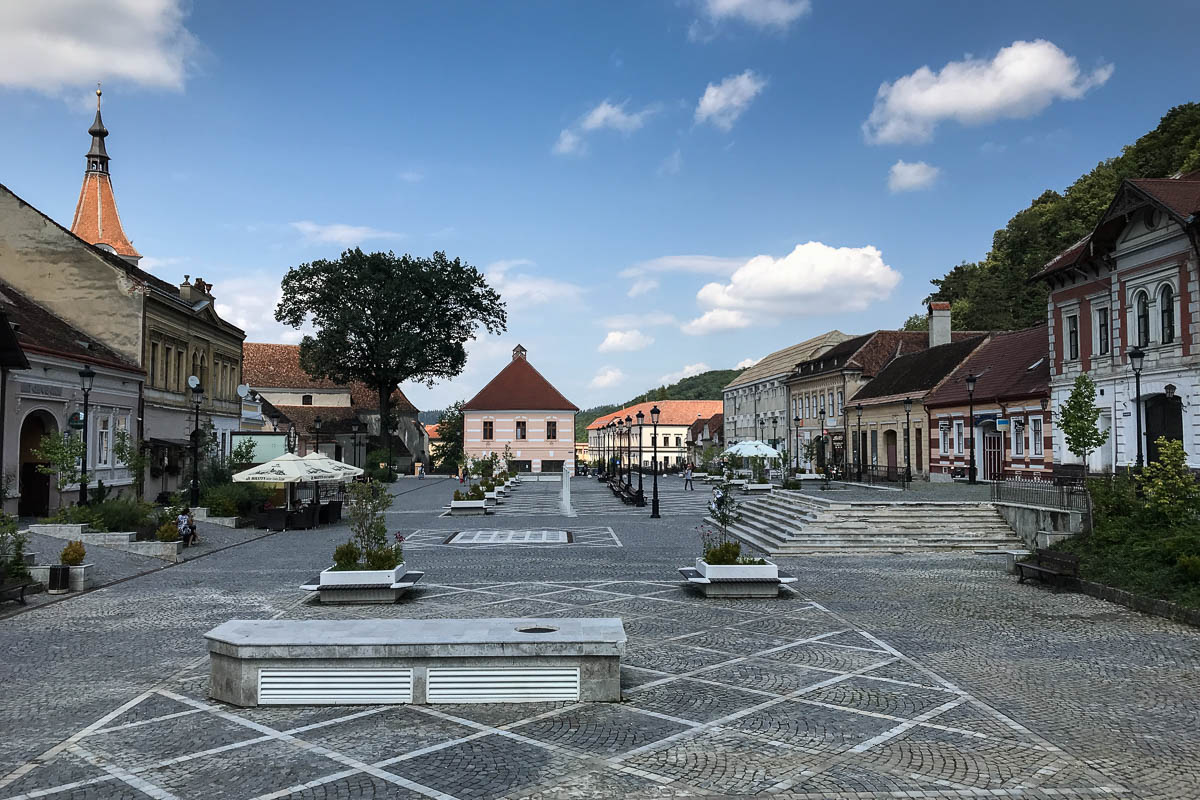
Above the town on the hill is the Rasnov Citadel, a medieval walled city. It’s an easy 10-minute walk through town to the funicular or walking path up to the citadel. The funicular costs 12 lei* per person round trip and runs every few minutes. Once at the top, it’s about a 10-minute walk over mostly flat ground to get to the entrance of the citadel.

The entrance fee is 12 lei* per person. The citadel was quite crowded, in contrast to the town, but still nowhere near as crowded as Bran. Most of the tourists visiting Rasnov appeared to be Romanians traveling by car. The parking lot is on the back side of the citadel, and a tram runs to the entrance.
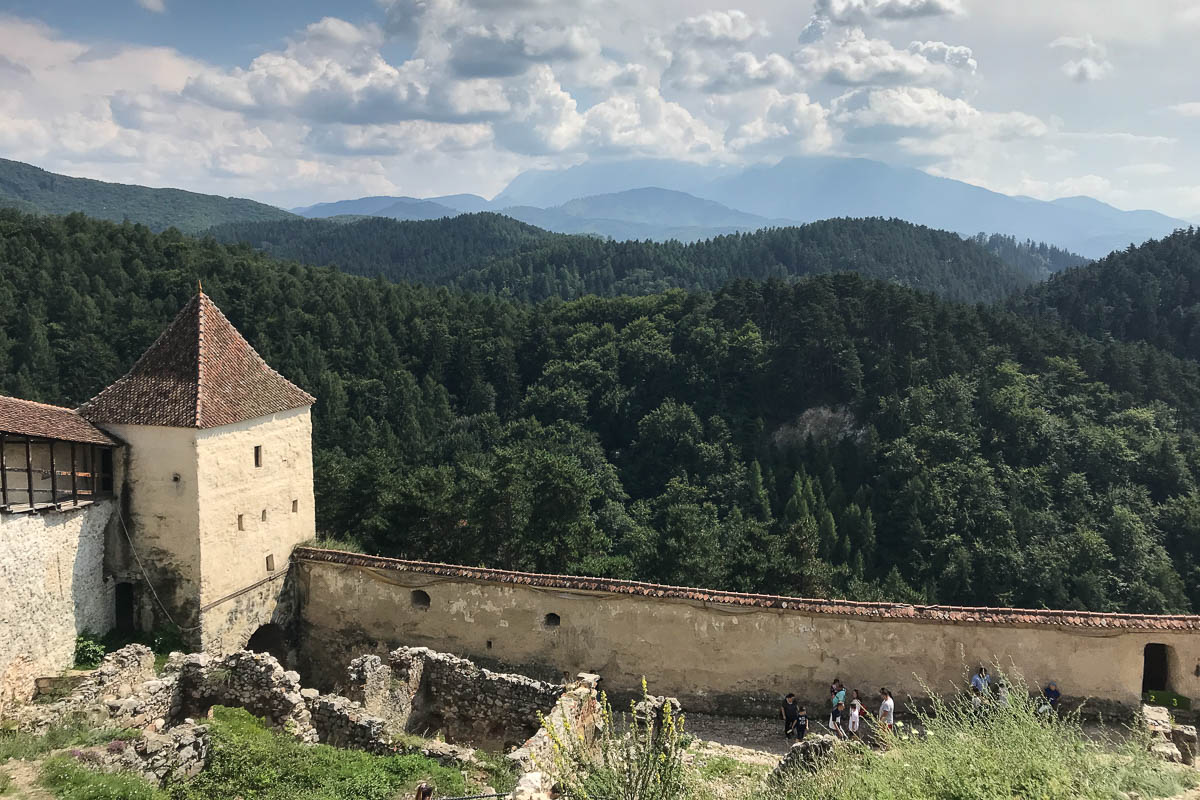
Once inside the entrance, most of Rasnov Citadel is a ruin, and the intact buildings have been converted to shops.
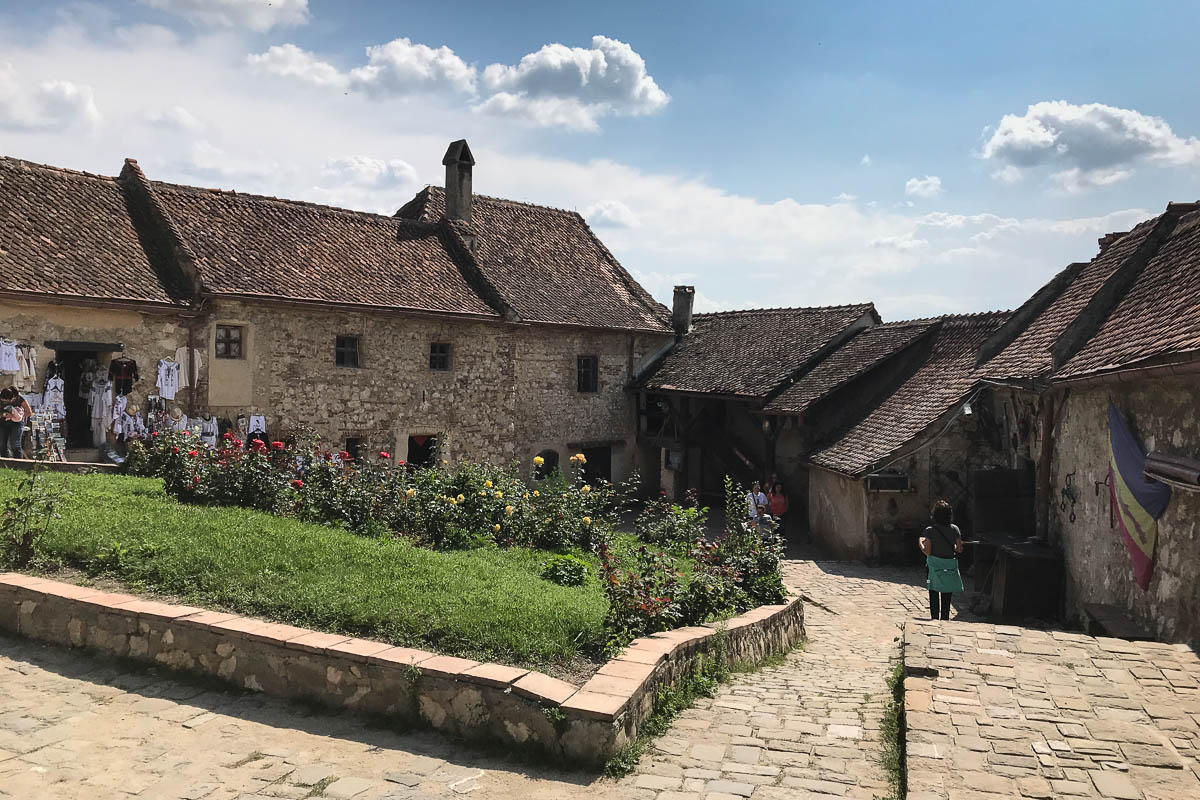
But it’s a pleasant way to get a feel for how a medieval town was structured and why they located the towns in these hills. The views are amazing; you could see enemies coming for miles around.

While at the Rasnov Citadel, if you’re so inclined, you can visit its neighbor, Dino Parc. Its the first stop on the tram from the parking lot. This mostly outdoor museum features large statues of dinosaurs, a 9D theater, playground, and other activities. We gave it a miss, but in retrospect, the 9D theater might have been pretty cool.
Sighisoara, Viscri, and Rupea Fortress – Our Favorite Day Trip from Brasov
Originally, we had planned to take a train to Sighisoara. Since it is a 3-hour train ride, it would have meant at least one overnight stay (double rent). It also meant that we wouldn’t be able to visit one of the fortified Saxon churches which are all out in the countryside. After stopping at the tourist office in Brasov, we discovered LandOfDraculaTours (campy name, huh?) which offered the perfect day trip for us. The cost was 39 Euros per person, with the option to add Viscri, Rupea Fortress, and Racos Volcano for an extra 5 Euros per person for each sight. Adding Viscri was a no-brainer, as we knew we wanted to visit a fortified church. We decided to throw in Rupea Fortress because why not. Traveling in the US, we’ve seen our share of volcanoes, so we passed on Racos. Luckily, we contacted the company ahead of time because they were fully booked for the following week, so we went during our last week in Brasov.
A pleasant surprise was that it wasn’t a group tour but a private car tour, with Raz as our driver and tour guide extraordinaire. Turns out Raz is an independent contractor who works for different companies and also does his own customized tours. We kept his contact info for when we return. Side tidbit: Raz works as a ski instructor at Poiana in the winter. Raz picked us up at our apartment and filled us in on centuries of Romanian history during our 2-hour drive to Sighisoara. He accompanied us the whole time and gave us details and insights about every sight we saw.
Sighisoara
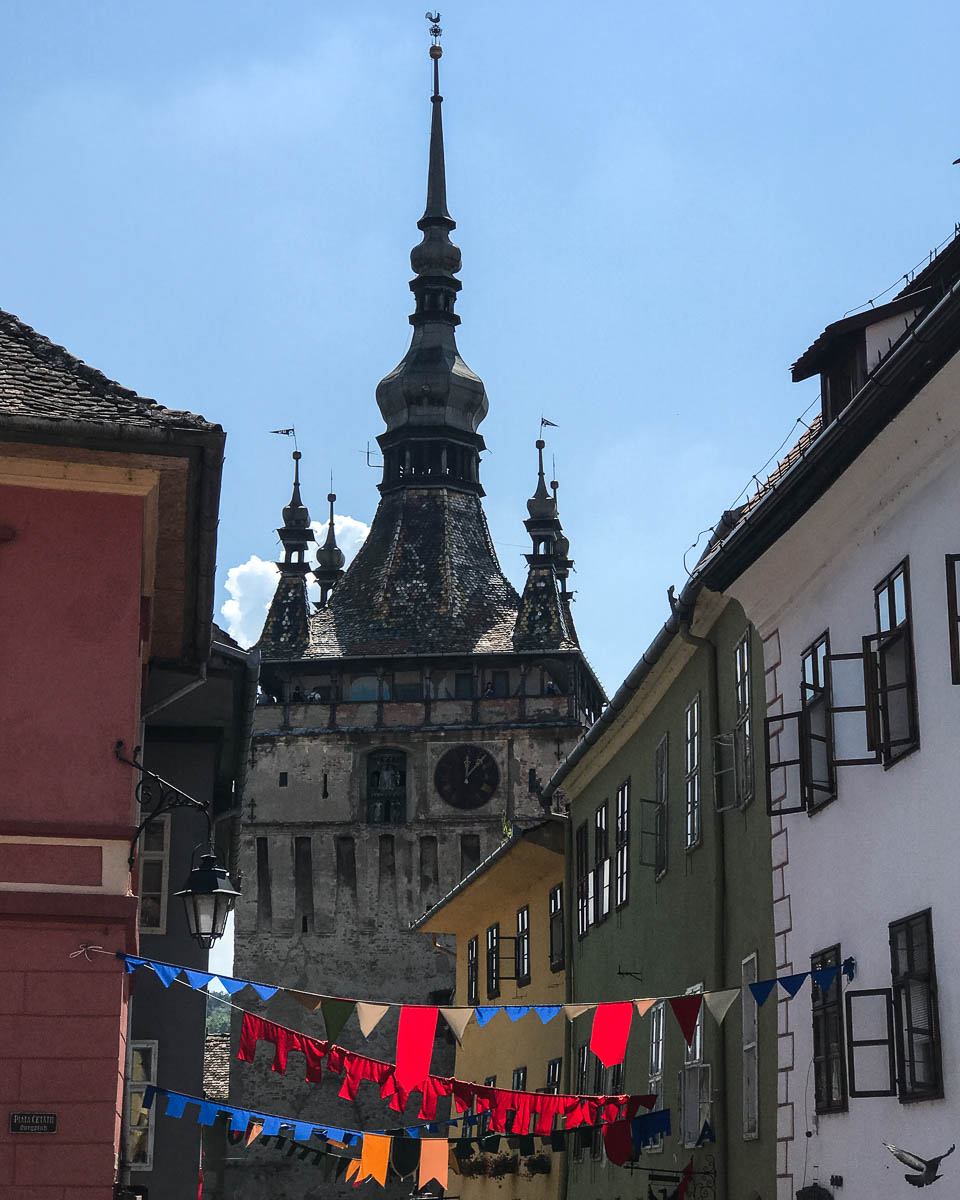
Sighisoara is the best-preserved citadel town in Romania. One of the main sights is the clock tower with its four traditional peaks indicating that the town has the power to execute people. We also saw multiple towers, bastions, manned by the various guilds in the Middle Ages. We learned that the guilds ran like a combination trade union and commune. Each craftsman’s work had to be up to snuff, and each member took what money they needed for the week. Money leftover was used for capital improvements.
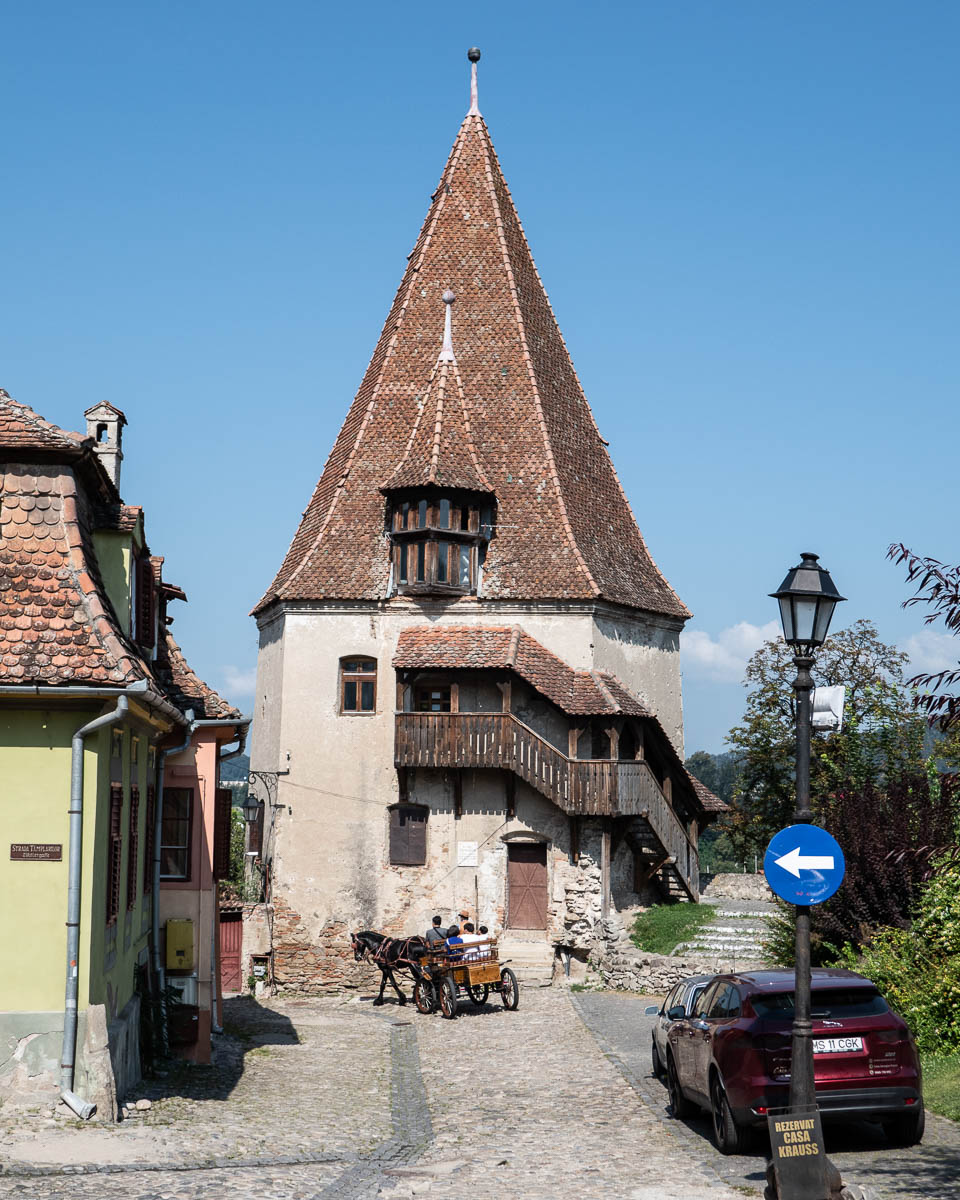
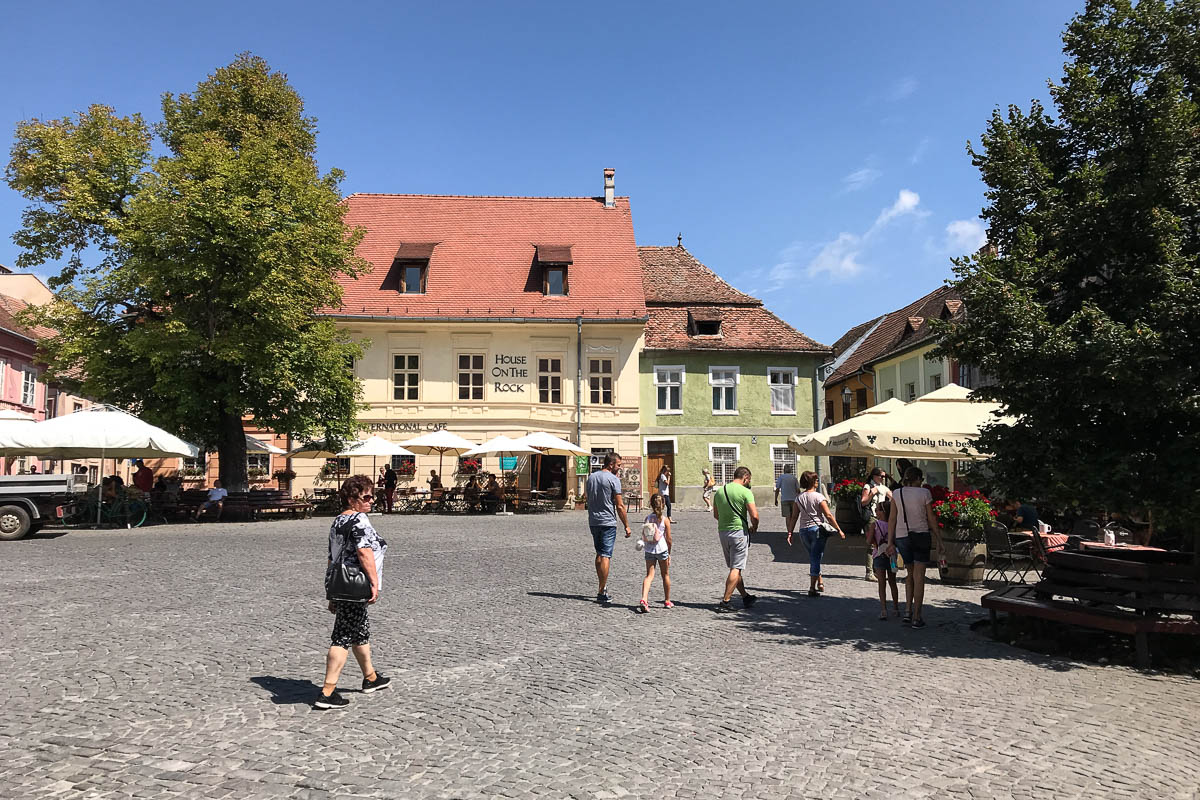
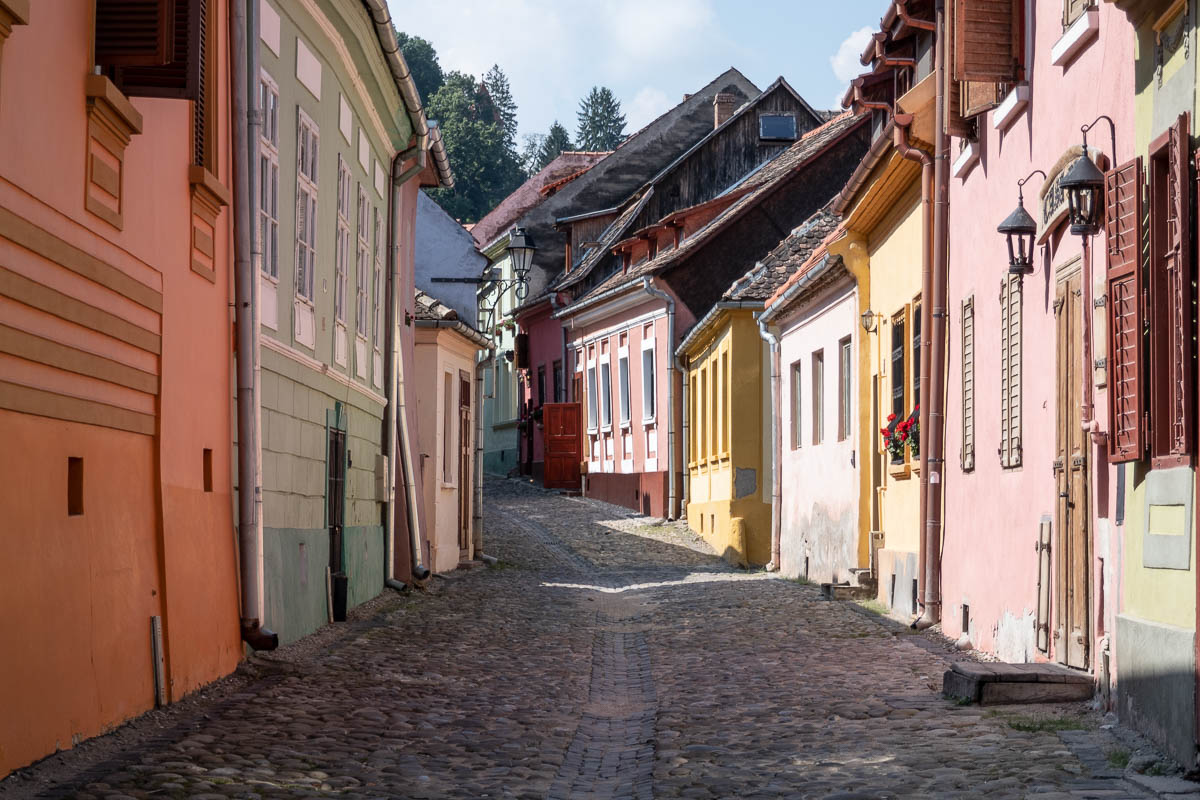
Other sites were the town square, multiple churches including two from the Middle Ages (one in the main part of town and one on the hilltop). This being a Saxon town, everything was about efficiency, so only one of the two churches had a bell. Can you guess why? Because each church having a bell would be a waste of money. A covered bridge, to protect children going to school in bad weather, connected the main part of town to the hilltop. Here was the school, church, and rather pleasant, slightly forested cemetery.

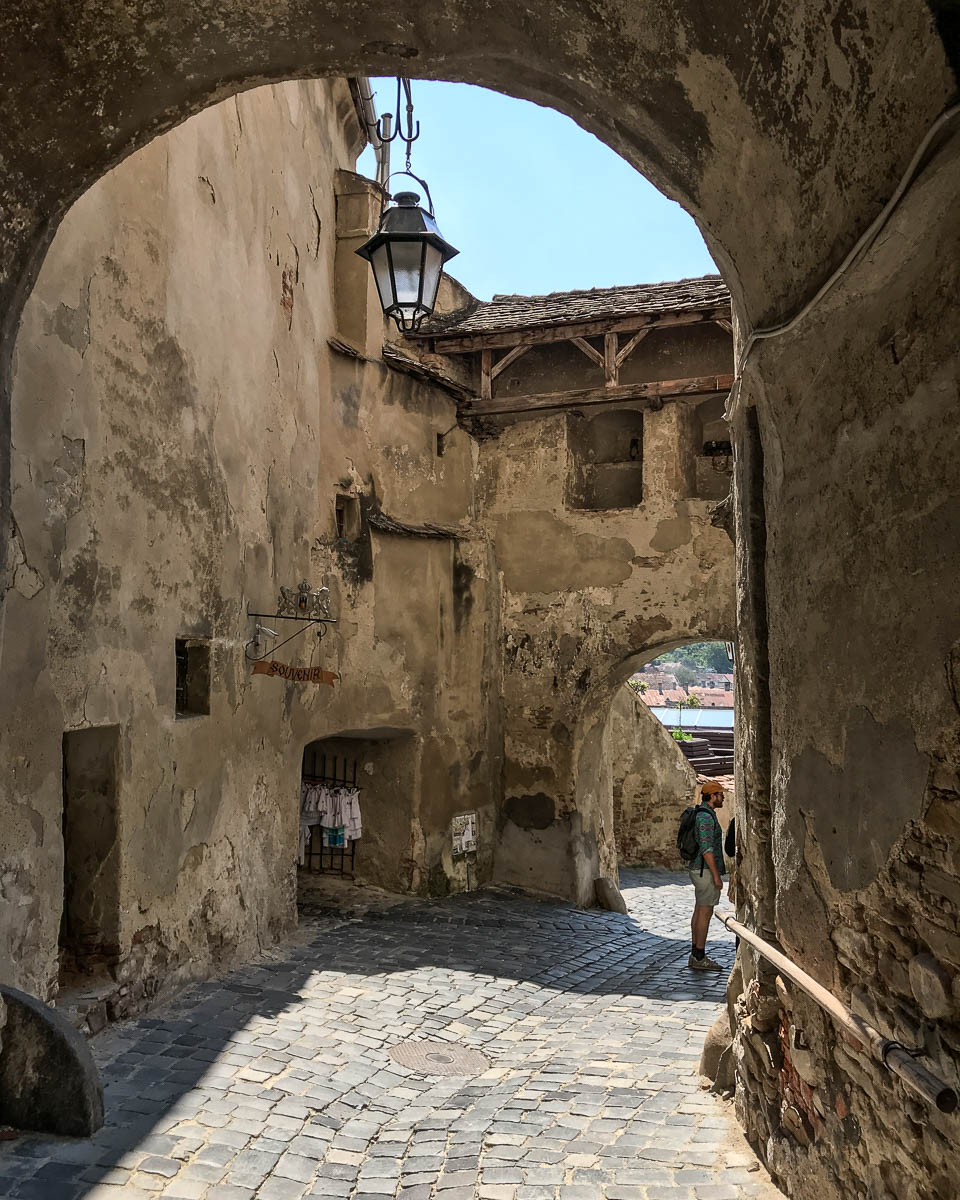
The Fortified Church Village of Viscri
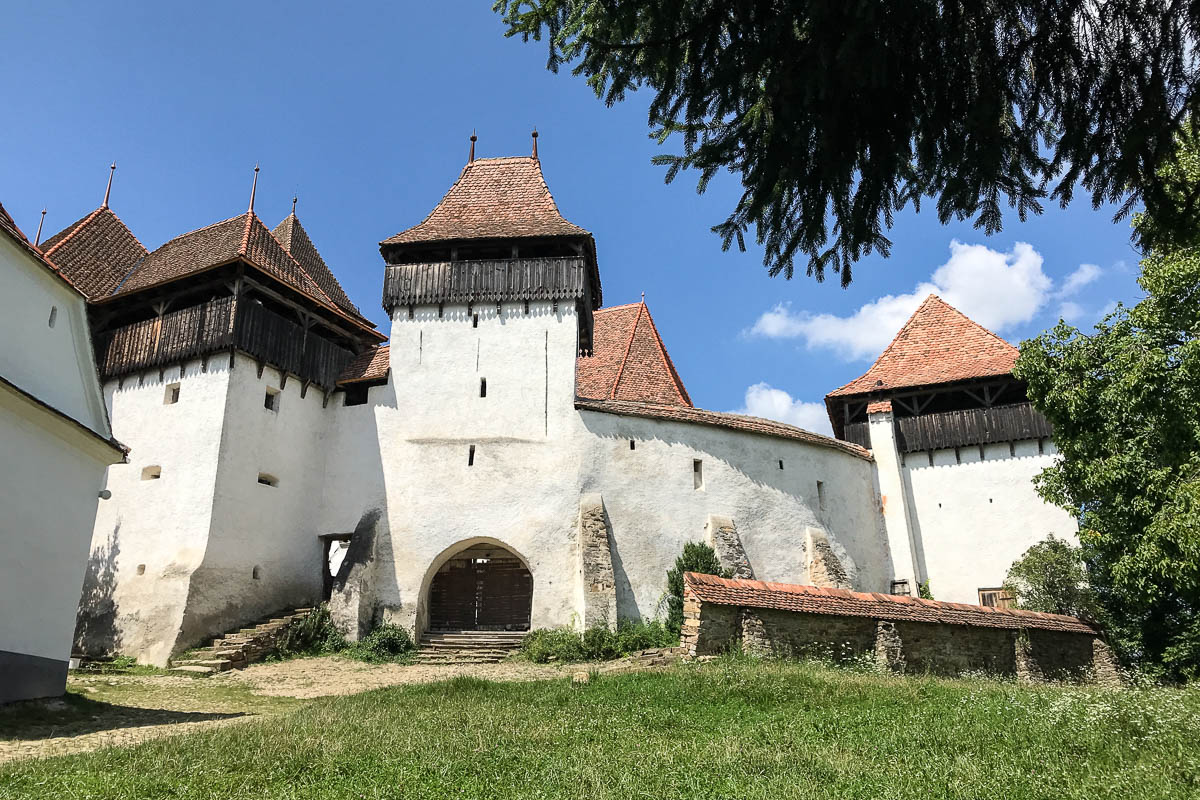
On the way back to Brasov, we stopped in Viscri, a small Saxon fortified church town about 5 km down a very badly maintained road. These towns were a unique aspect of medieval Transylvania.

During normal times, the village was just like any other, with people living in their own houses. But rather than have a castle in which to retreat during an attack, the church became the fortification, with three sets of walls. During a siege, animals were kept between the first and second walls. The people lived between the second walls and the walls surrounding the church. Inside the church walls was the final refuge if an enemy breached both of outside walls. People lived inside the walls anywhere from a few days to months.
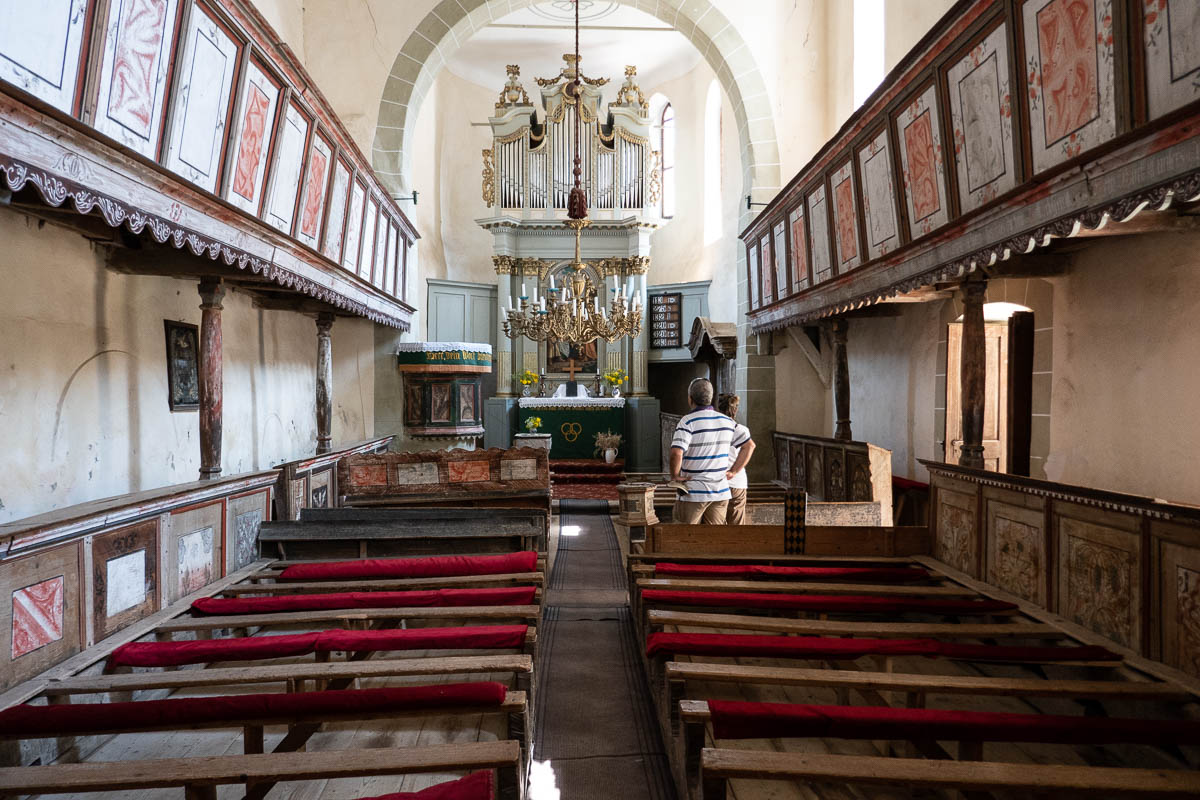
The church was the highest building, with armed turrets. Food and wealth were stored in the attic of the church or between the second and third walls. Each family marked their aged meat and other stores with the family name. Once a week, on Sundays, the family went to retrieve part of their store, with the gatekeeper making sure that people only took what was theirs.
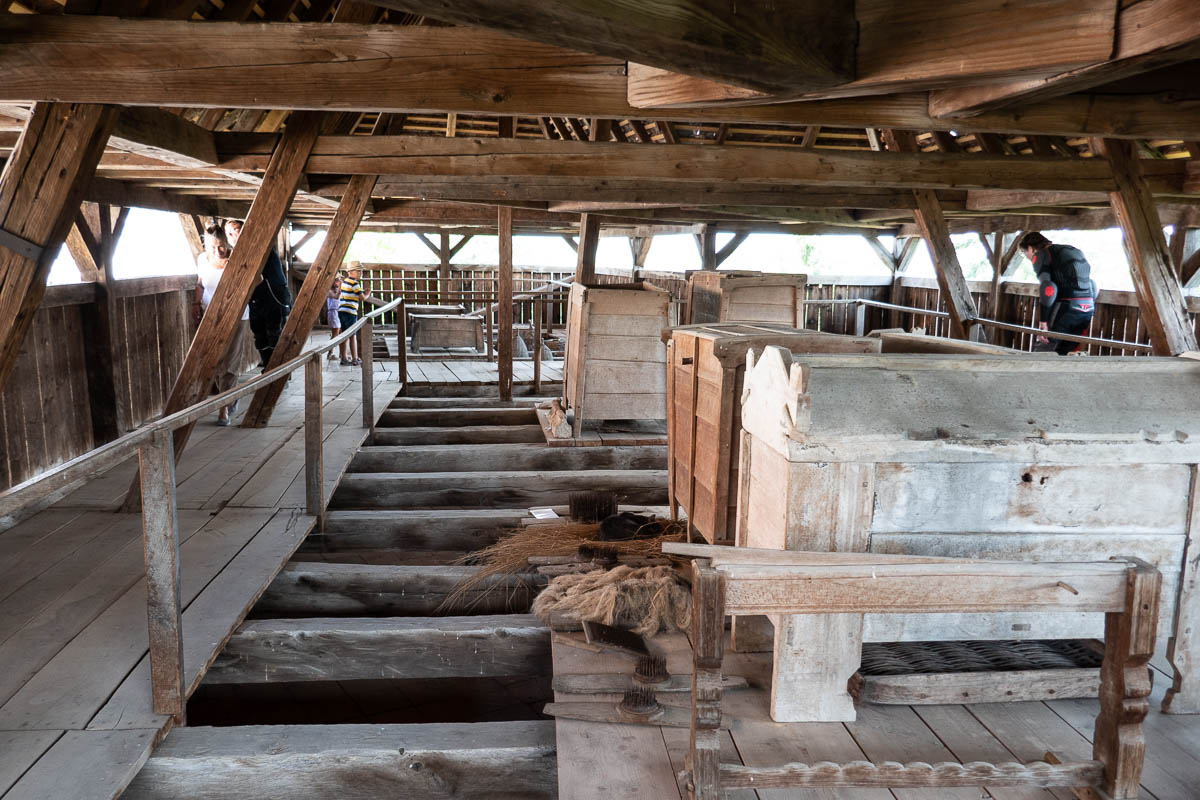
Prince Charles of England has a fondness for this area of Transylvania and has purchased a house (which is available as a rental) in Viscri. He also established a foundation to preserve the traditional ways of life.
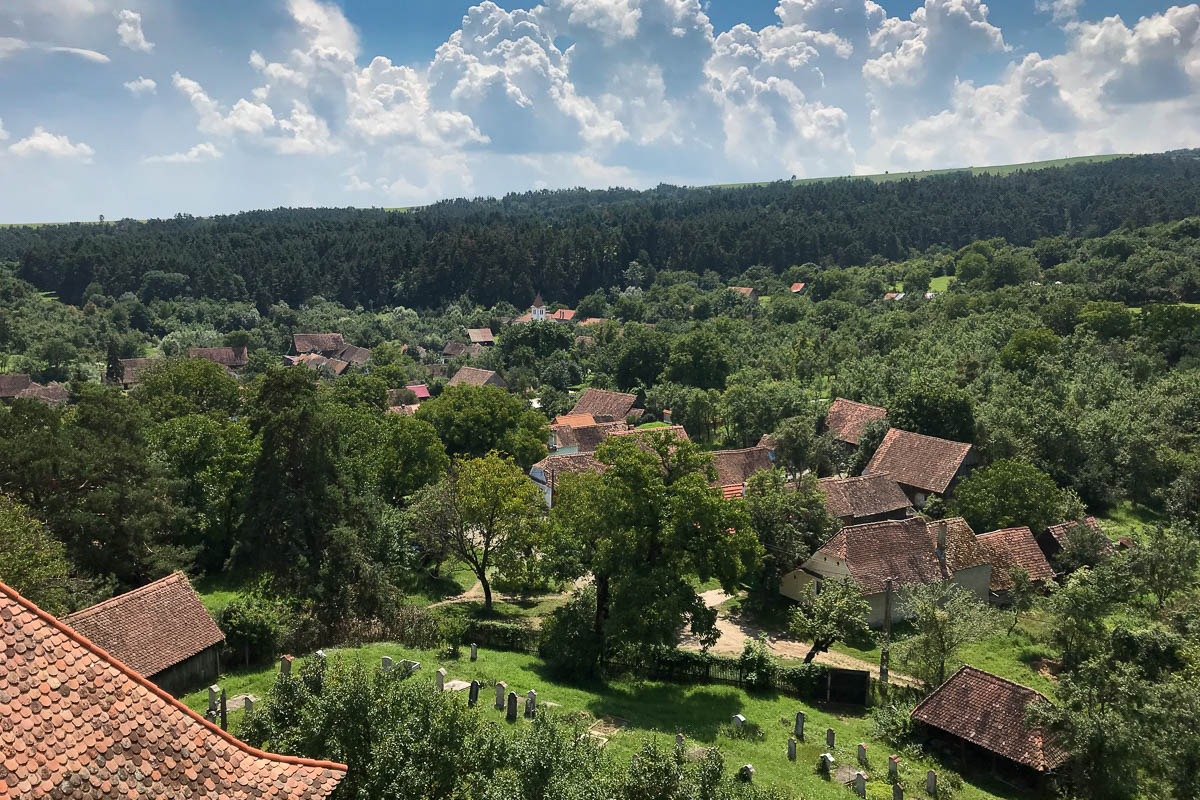
Lunch on the Farm
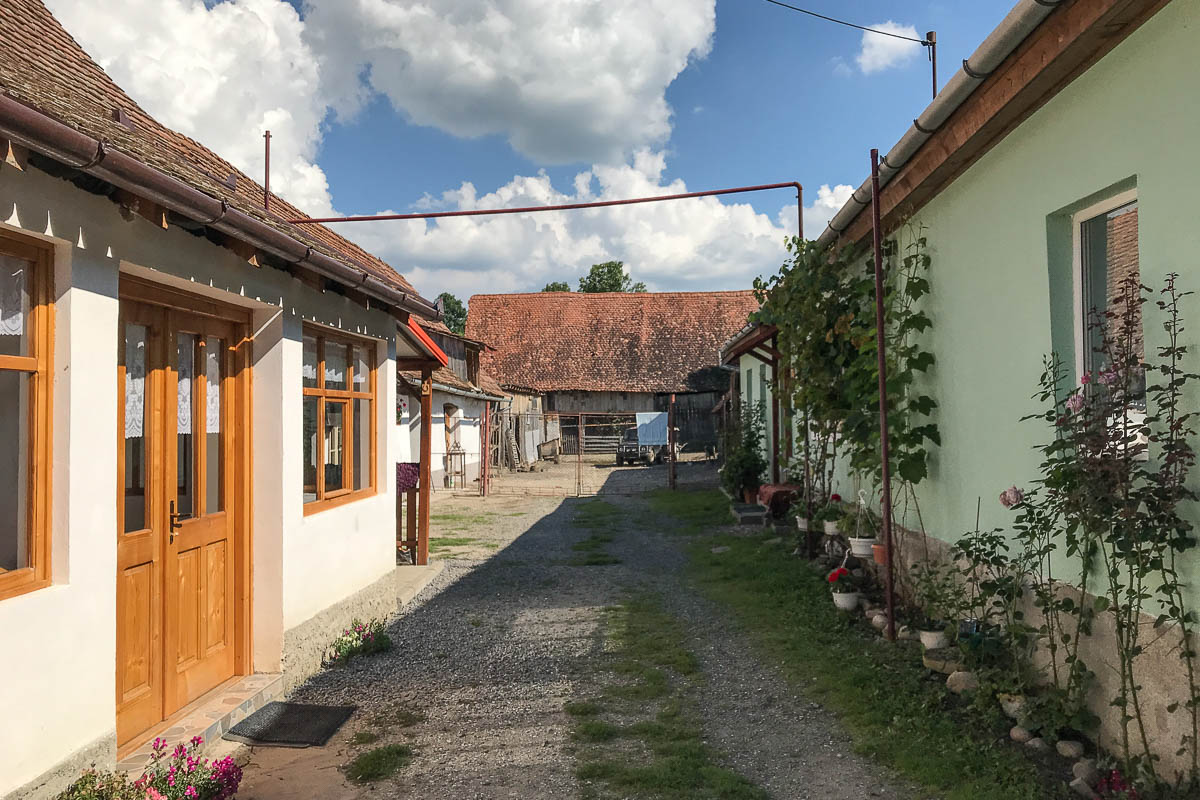
The highlight of our day was that we got to have lunch in the home of a local farmer. (Raz offered us this option on the drive out, as he needed to give the farmer a couple hours’ notice.) Two hours of hospitality and lots of delicious, wholesome food, all sourced from the farm. Even the tuică, the traditional Romanian spirit prepared from plums, came from the farm. Side note: we found out that stills are sold at the local equivalent of Home Depot.
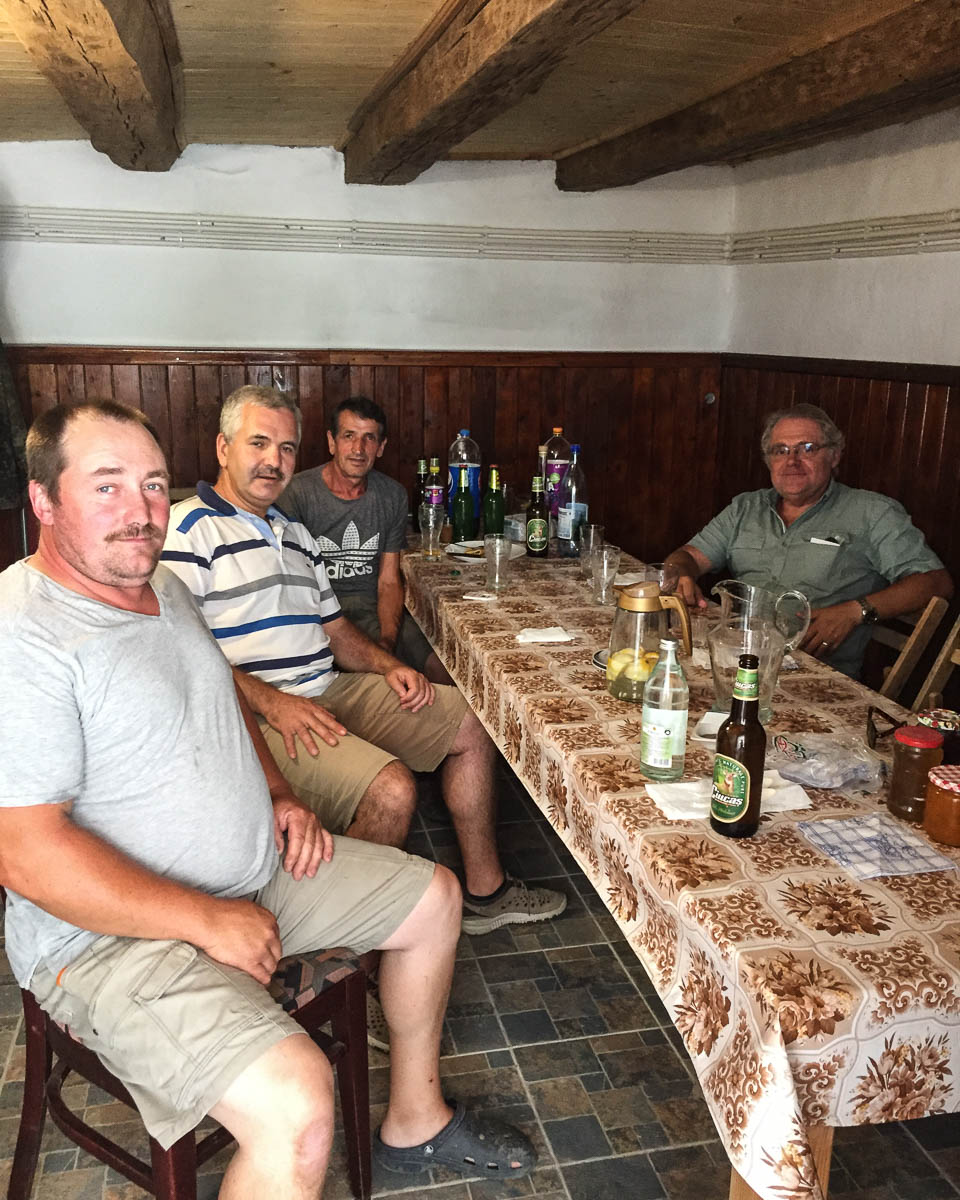
The only sad aspect of our visit is that we learned that young people are leaving Romania to work in other parts of Europe. Hence, these unique towns are dying.
Rupea Fortress

Our final stop for the day was at the Rupea Fortress. We wandered around the outside but by this point were tired and opted not to visit the inside. Especially after Raz filled us in on how the EU-funded reconstruction turned out wrong and has historians in an uproar. The company hired (by local officials, not the EU) to restore the fortress did all sorts of things which are not historically correct. Such as stucco over the walls, putting half circles embellishments on the walls to make them look fancier for the tourists. Which led Ian to joke that the difference between a commission and a bribe is that he first is legal but the second not.
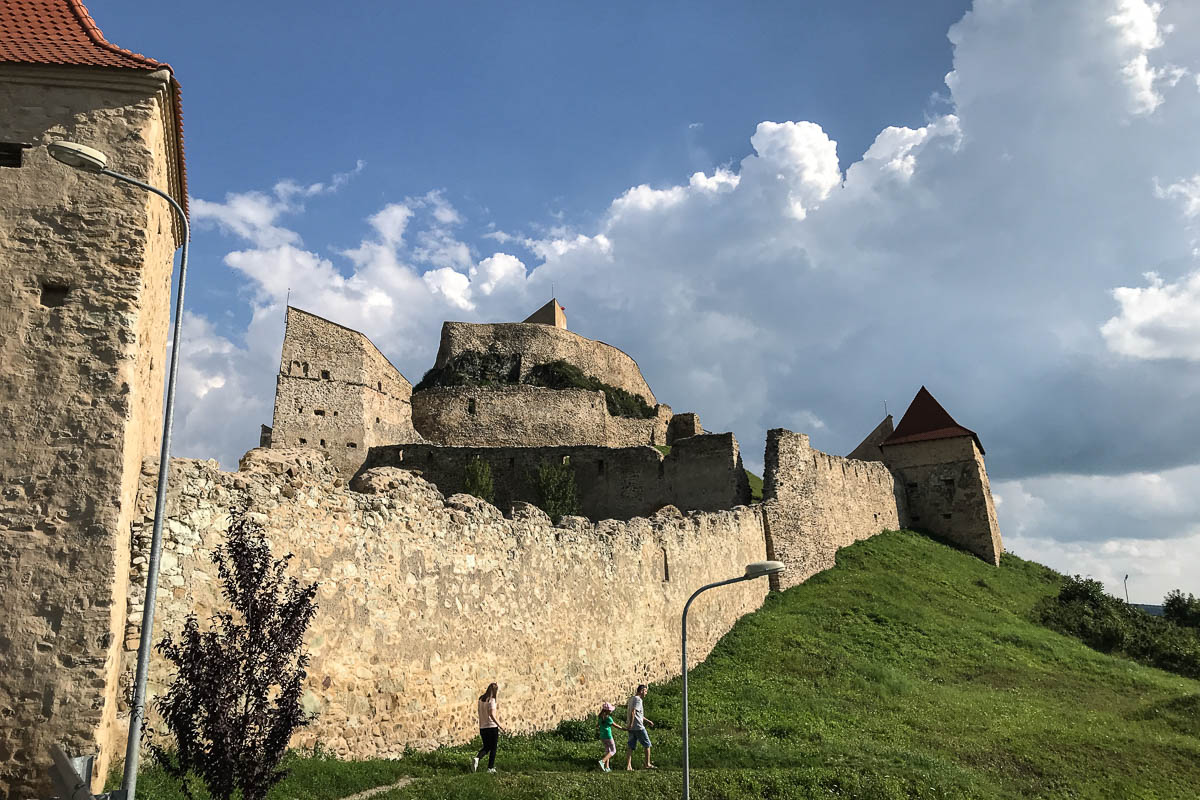
It was a very long, very fulfilling, and very tiring day. But we are so glad we did it!
Sinaia

Our final four days in Romania were spent in the mountain resort town of Sinaia, home of Peles Castle. It is possible to do this as a day trip from Brasov. As a matter of fact, Raz does a tour which visits Peles, Bran, and Rasnov in one day. We might have considered this option if our Brasov Airbnb had been available until we were scheduled to leave Romania, but alas it wasn’t. So we decided to stay in Sinaia, which is part of the way back to Bucharest. Side note: shuttles though DirectAiport are available from Sinaia and Brasov to Bucharest Airport, avoiding the need to go into Bucharest before flying out.
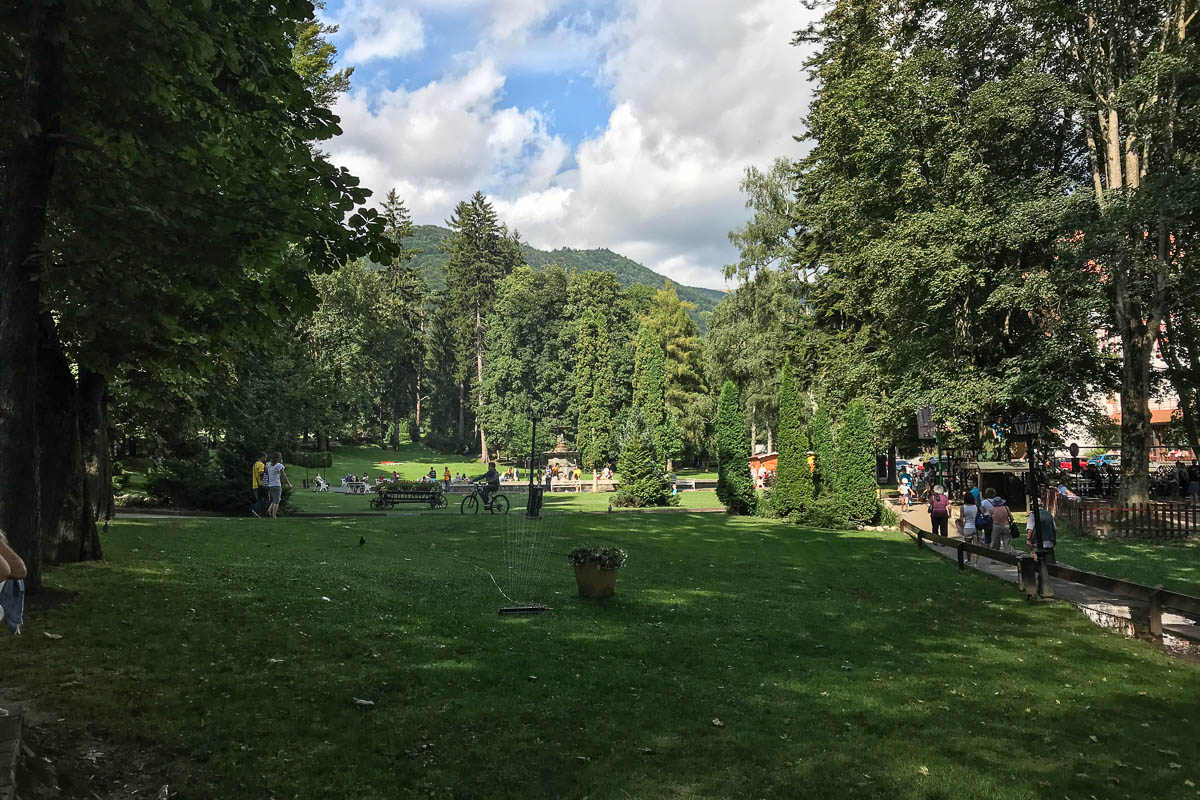
Sinaia is a pleasant, scenic, woodsy small town in which to relax (which we did), with near perfect weather in August. The picturesque downtown area has a large park and plenty of restaurants. The main draw in Sinaia is:
Peles Castle
More of a palace really, Peles Castle was built in the late 1800’s by Romania’s first king, King Carol I, as a summer residence. We arrived about 9:10 am and bought tickets, adult 60 lei*, senior 30 lei* (nice discount!) to include visiting both the first and second floors. It costs an extra 30 lei* for a photography pass to take photos inside the castle. (Notice: no photos of the inside here.)
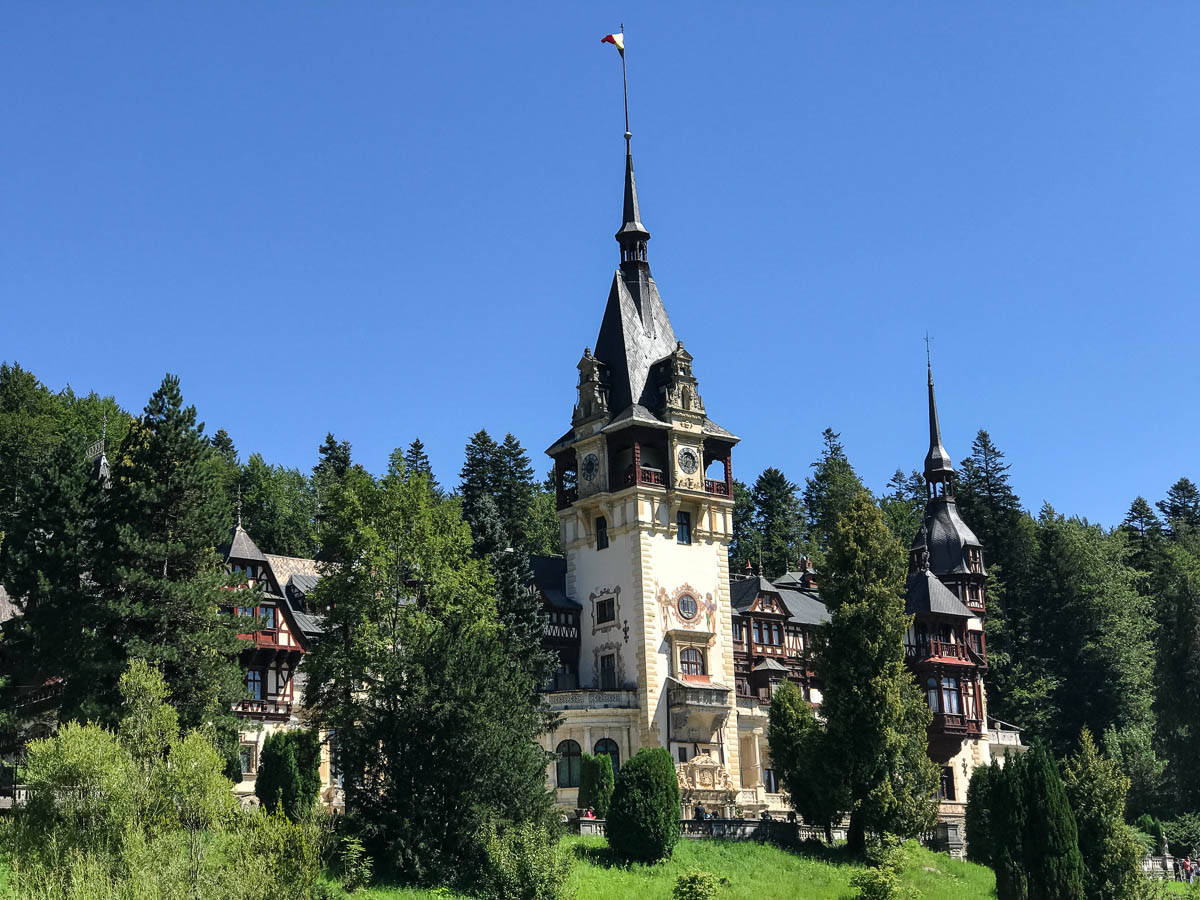
We had to wait until about 10 am before getting ushered inside for a mandatory guided tour. (When the doors opened at 9:30, one group of independent travelers were let in, followed by three tour groups.) Our guide was knowledgeable and with the optional second floor, the tour took about an hour and a half. Peles was a treat to walk around. We very much enjoyed the tour of this opulent “castle” with its huge spaces filled with fine furnishings and exquisite craftsmanship in its interior construction.
Pelisor Castle

King Carol I had this much smaller castle built for his nephew and heir, Ferdinand, and his wife, Mary. Built between 1899 and 1902, it is about 200 yards away on the same grounds. This tour is self-guided, doesn’t get near the crowds that Peles gets, and costs 20 lei* for adults and 10 lei* for seniors, with the same camera rules as at Peles. Queen Mary, herself an accomplished artist, directed most of the décor, with a tendency toward Art Nouveau style. Ian didn’t care for her style at all.
Transfagarasan
Although we didn’t go, another big attraction in the area is the Transfagarasan, as seen on Top Gear. The Transfagarasan is a very winding, scenic road through the Carpathian Mountains. We present a video compliments of Arina and Jim, a couple of our new friends in Brasov.
Sibiu can also be visited as a day trip from Brasov, but we spent three days there before going to Brasov.
Romania Wrap-up
As we’ve previously mentioned, we really enjoyed our time in Romania and are considering returning next summer. In the mountains of Transylvania, the summer weather is temperate, the scenery is wonderful, and days are very long. While not as inexpensive as Bosnia, it is quite reasonable. We averaged $75 per day for two people including lodging, groceries, eating out (usually one meal a day every other day), medical and dental care, attractions, and local transportation. Tune in for next summer’s second installment on Romania.
*At time of writing, 1 leu (singular of lei) = $ .25.
Next Up: Warsaw Poland
Ian & Ann

4 Comments
Romania sounds great. Sounds like a place I would like to visit. My dad was from Poland so I will be interested to see where you are visiting. He grew up in a village outside of Chestshova. I probably spelled that wrong.
Hi Robin,
You along with several others have had the same reaction, that Romania sounds like a place you’d like to visit. We certainly liked it very much.
We looked up that village you mentioned, and you came really close with the spelling. It’s Chestohova, and it’s about 113 km (70 mi) outside of Krakow (nearest large city), north and a bit west.
Ian & Ann
Your pictures and notes are so good that I feel like I’ve taken this trip with you, but at no cost and with no lost luggage.
Hi Art,
Just the way you like to travel! And no carbon footprint on your part.
Ian & Ann